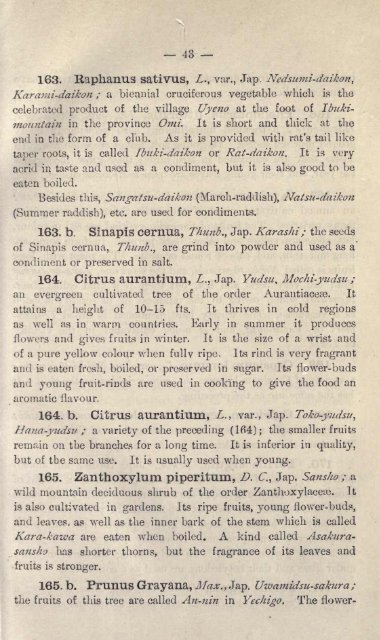Untitled - Library
Untitled - Library
Untitled - Library
You also want an ePaper? Increase the reach of your titles
YUMPU automatically turns print PDFs into web optimized ePapers that Google loves.
163. Raphanus satiVUS, L., var., Jap. Nedsnmi-daikon,<br />
Karaiui-daikon ; a biennial cruciferous vegetable which is the<br />
celebrated product of the village Uyeno at the foot of Ibukimountain<br />
in the province Omi. It is short and thick at the<br />
end in the form of a club. As it is<br />
provided<br />
with rat's tail like<br />
taper roots, it is called Ilmki-daikon or Rat-daikon. It is very<br />
acrid in taste and used as a condiment, but it is also good to be<br />
eaten boiled.<br />
Besides this, Sangatsu-daikon (March-raddish), Natsu-daikon<br />
(Summer raddish), etc. are used for condiments.<br />
163. b. SinapiS cernua, Thunb., Jap. Karashi ; the seeds<br />
of Sinapis cernua, Tint-lib., are grind into powder<br />
condiment or preserved in salt.<br />
and used as a'<br />
164. Citrus aurantium, ., Jap. Yudsu, Mochi-yudsu ;<br />
an evergreen cultivated tree of the order Aurantiacea3. It<br />
attains a height of 10-15 fts. It thrives in cold regions<br />
as well as in warm countries. Early in summer it produces<br />
flowers arid gives fruits in winter. It is the size of a wrist and<br />
of a pure yellow colour when fully ripe.<br />
Its rind is<br />
very fragrant<br />
and is eaten fresh, boiled, or preserved in sugar. Its flower-buds<br />
and young fruit-rinds are used in cooking to give<br />
aromatic flavour.<br />
the food an<br />
164. b. Citrus aurantium, L., var., Jap. Toko-yudsu,<br />
Hatia-yudsu ; a variety of the preceding (164); the smaller fruits<br />
remain on the branches for a long time. It is inferior in quality,<br />
but of the same use. It is usually used when young.<br />
165. Zanthoxylum piperitum, D. C., Jap. Sansho ; a<br />
wild mountain deciduous shrub of the order Zanthoxylaceas. It<br />
is also cultivated in gardens. Its ripe fruits, young flower-buds,<br />
and leaves, as well as the inner bark of the stem which is called<br />
Kara-kaiva are eaten when boiled. A kind called AsakurasaiisJio<br />
has shorter thorns, but the fragrance of its leaves and<br />
fruits is stronger.<br />
165. b. Prunus Grayana, Max., Jap. Uwamidsu-sakura ;<br />
the fruits of this tree are called Au-nin in Yechigo. The flower-
















